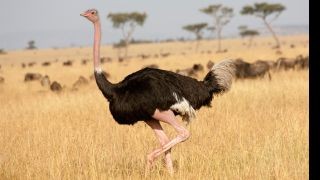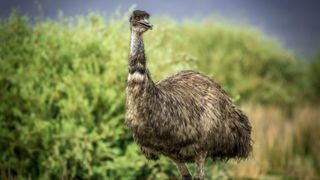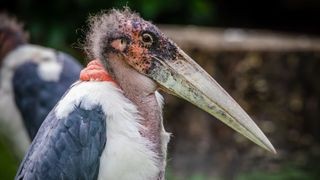What Is The Largest Bird In The World? It’s a question WHAT.EDU.VN is here to answer! Discover fascinating facts about these avian giants, their habitats, and unique characteristics. We provide comprehensive, easy-to-understand information. Learn about these magnificent creatures and explore the world of avian giants. Need more answers about birds or any other topic? WHAT.EDU.VN offers a free question-and-answer service, providing expert insights on everything from the biggest birds to the smallest insects.
1. Introduction: Avian Giants of the World
The world of birds is incredibly diverse, with nearly 10,000 species inhabiting every corner of the globe. These avian creatures come in a stunning array of shapes and sizes, from the minuscule bee hummingbird to the truly colossal ostrich. But what is the largest bird in the world? This article delves into the realm of these avian giants, exploring the tallest, heaviest, and those with the most impressive wingspans. Whether you’re a student, a nature enthusiast, or simply curious, join us as we uncover the remarkable facts about the largest birds on our planet. And remember, for all your questions, WHAT.EDU.VN is here to provide clear and reliable answers. We’ll explore different types of big birds including flightless birds, giant birds, sea birds and birds of prey.
2. The Ostrich: The Undisputed King of Size
When asking what is the largest bird in the world, the answer is unequivocally the ostrich (Struthio camelus). Native to Africa, these birds are not only the tallest but also the heaviest of all living bird species. Male ostriches can reach heights of up to 9 feet (2.7 meters) and weigh as much as 287 pounds (130 kilograms), according to the San Diego Zoo Wildlife Alliance. Their imposing size makes them a true spectacle of nature.
2.1. Flightless Giants
Despite possessing wings that can span up to 7 feet (2 meters), ostriches are flightless. Instead, they use their wings for balance and display, much like a ship uses its sails for stability and steering. This adaptation has allowed them to thrive in open savanna environments where speed and agility are more crucial for survival than flight.
2.2. Speed and Agility
Ostriches are renowned for their incredible speed, capable of reaching up to 43 miles per hour. Their powerful legs and clawed feet not only enable them to outrun predators but also serve as formidable weapons. In fact, an ostrich kick can be powerful enough to kill a lion, as noted by PBS Nature.
2.3. Habitat and Diet
Ostriches are primarily found in the savannas and deserts of Africa. They are omnivorous, feeding on a diet of grasses, seeds, insects, and occasionally small vertebrates. Their ability to survive in harsh environments is a testament to their adaptability and resilience.
Alt text: A male ostrich walking through the green grass of Serengeti National Park, Tanzania.
3. The Emu: Australia’s Towering Bird
Following the ostrich, the emu (Dromaius novaehollandiae) stands as the second-tallest bird in the world. These flightless birds are native to Australia and can reach heights of up to 6.2 feet (1.9 meters). Emus are well-adapted to the Australian landscape and play a vital role in the ecosystem.
3.1. Nomadic Lifestyle
Emus are nomadic birds, roaming across Australia in search of food and water. Their long, powerful legs enable them to cover vast distances, reaching speeds of up to 31 mph (50 km/h), according to the Smithsonian’s National Zoo and Conservation Biology Institute.
3.2. Parental Care
One of the most fascinating aspects of emu behavior is their parental care. The males incubate the eggs, remaining on the nest without eating, drinking, or defecating for around 56 days, as noted by the Australian Museum. This dedication ensures the survival of their offspring.
3.3. Habitat and Diet
Emus are found across a variety of habitats in Australia, from grasslands to forests. They are omnivorous, feeding on a diet of seeds, fruits, insects, and small animals. Their adaptability allows them to thrive in diverse environments.
Alt text: An emu standing in the grassland, looking towards the right with its beak slightly open in Queensland, Australia.
4. The Wandering Albatross: Master of the Skies
While the ostrich and emu claim the titles for height and weight, the wandering albatross (Diomedea exulans) reigns supreme in terms of wingspan. These seabirds possess the largest wingspan of any living bird, reaching up to almost 11 feet (3.35 meters), according to the International Union for the Conservation of Nature (IUCN).
4.1. Gliding Experts
The immense wingspan of the wandering albatross allows them to spend vast amounts of time in the air, gliding effortlessly over the ocean. One bird was recorded to have wandered around 3,700 miles (6,000 km) in just 12 days.
4.2. Threats to Survival
Despite their remarkable adaptations, wandering albatrosses face significant threats, primarily from getting caught in fishing hooks while scavenging for food. This has led to many albatross species being classified as threatened or endangered.
4.3. Habitat and Diet
Wandering albatrosses are found in the Southern Ocean, circling Antarctica and the southern tips of South America, Africa, and Australia. They feed primarily on squid and fish, which they catch from the surface of the water.
Alt text: A pair of wandering albatross flying over snowy mountains in South Georgia Island, Antarctica showcasing their impressive wingspan.
5. Other Notable Large Birds
While the ostrich, emu, and wandering albatross are the most prominent examples, several other bird species also deserve recognition for their impressive size and unique characteristics.
5.1. Marabou Stork (Leptoptilos crumenifer)
Marabou storks are the largest stork species in the world, reaching up to 5 feet tall. Often called “undertaker birds” due to their dark wings and scavenging habits, they are found across sub-Saharan Africa.
5.2. Harpy Eagle (Harpia harpyja)
Harpy eagles are among the largest eagles in the world, with females weighing up to 20 pounds (9 kg). These powerful birds of prey inhabit the tropical lowland forests of South America.
5.3. Greater Rhea (Rhea americana)
The Greater Rhea is a South American relative of the ostrich, standing up to 5 feet tall and weighing around 66 pounds (30 kg). They are flightless and use their wings for balance while running.
5.4. Cassowary (Casuarius casuarius)
Cassowaries are native to New Guinea and Australia. Towering up to 6 feet (2 m) tall, cassowaries are one of the tallest birds on Earth, Topping off their height is a prominent helmet called a casque. They are known for their dangerous claws and aggressive behavior.
5.5. Dalmatian Pelican (Pelecanus crispus)
The Dalmatian pelican is the largest species of pelican, with a wingspan of around 11 feet (3 m). These birds are found in Europe and Asia and are known for their large bill pouches used for catching fish.
5.6. Shoebill (Balaeniceps rex)
Shoebills are one of Africa’s strangest and tallest birds. Also known as whale-headed storks, stand at around 5 feet (1.5 m) tall and spend their time wading amongst freshwater swamps and marshes hunting fish and other small aquatic species,.
5.7. Great Bustard (Otis tarda)
Great bustards are the largest land bird in Europe. Males can weigh up to 31 pounds (14 kg) and stand almost 4 feet (1.2 m) tall.
5.8. Emperor Penguin (Aptenodytes forsteri)
Of all the 18 species of penguins on Earth, emperor penguins are the biggest. They stand around 4 feet (1.2 m) tall and weigh around 88 pounds (40 kg).
5.9. Andean Condor (Vultur gryphus)
The Andean condor is the largest species of raptor on the planet and the second-largest wingspan of any bird which spans around 10.5 feet (3.2 m).
6. Why Size Matters: Adaptations and Survival
The size of these birds is not merely a curiosity but a crucial factor in their survival. Large size often correlates with specific adaptations that enable these birds to thrive in their respective environments.
6.1. Predator Avoidance
For flightless birds like ostriches and emus, large size provides a significant advantage in predator avoidance. Their height allows them to spot potential threats from a distance, and their speed enables them to outrun many predators.
6.2. Energy Efficiency
For seabirds like the wandering albatross, a large wingspan is essential for energy-efficient flight. The ability to glide for long distances without expending much energy is crucial for foraging over vast oceanic expanses.
6.3. Dominance and Competition
In some species, large size is an indicator of dominance and plays a role in competition for mates and resources. For example, the larger males of certain bird species are often more successful in attracting females and defending territories.
7. Conservation Concerns
Many of the world’s largest birds face significant conservation challenges. Habitat loss, hunting, and climate change are among the factors threatening their populations. Conservation efforts are crucial to ensure the survival of these magnificent creatures for future generations.
7.1. Habitat Protection
Protecting and restoring the habitats of large birds is essential for their survival. This includes preserving forests, grasslands, and wetlands, as well as implementing sustainable land management practices.
7.2. Anti-Poaching Measures
Many large birds are targeted by hunters for their meat, feathers, and eggs. Anti-poaching measures, such as increased patrols and stricter enforcement of hunting regulations, are necessary to protect these species.
7.3. Climate Change Mitigation
Climate change poses a significant threat to many bird populations, altering their habitats and food sources. Efforts to mitigate climate change, such as reducing greenhouse gas emissions and promoting renewable energy, are crucial for the long-term survival of these species.
8. Fascinating Facts About Large Birds
Here are some additional intriguing facts about the largest birds in the world:
- Ostrich Eggs: Ostrich eggs are the largest of any living bird, weighing up to 3 pounds (1.4 kg).
- Albatross Lifespan: Wandering albatrosses can live for over 50 years, spending much of their lives at sea.
- Cassowary Diet: Cassowaries are frugivores, playing a vital role in seed dispersal in their forest habitats.
- Emperor Penguin Adaptations: Emperor penguins can hold their breath for up to 20 minutes while diving for food.
9. Frequently Asked Questions (FAQs)
| Question | Answer |
|---|---|
| What is the largest bird in the world by height? | The ostrich is the tallest bird, reaching up to 9 feet (2.7 meters). |
| What is the heaviest bird in the world? | The ostrich is also the heaviest, weighing up to 287 pounds (130 kg). |
| Which bird has the largest wingspan? | The wandering albatross has the largest wingspan, reaching up to almost 11 feet (3.35 meters). |
| Are ostriches able to fly? | No, ostriches are flightless birds. |
| Where do emus live? | Emus are native to Australia and can be found in a variety of habitats across the country. |
| What do wandering albatrosses eat? | Wandering albatrosses primarily feed on squid and fish. |
| Are cassowaries dangerous? | Yes, cassowaries are known for their sharp claws and aggressive behavior, and have been known to kill humans. |
| What is the conservation status of albatrosses? | Many albatross species are threatened or endangered due to getting caught in fishing gear. |
| How long can emperor penguins hold their breath? | Emperor penguins can hold their breath for up to 20 minutes while diving for food. |
| What role do large birds play in their ecosystems? | Large birds play various roles, including predator control, seed dispersal, and nutrient cycling. |
| Where can I learn more about birds? | Websites such as the Royal Society for the Protection of Birds (RSPB), Birds of the World by Cornell Lab of Ornithology, and the IUCN Red List are great resources. |
| How does size help birds survive? | Size aids in predator avoidance, energy efficiency, and competition for resources. |
| What are the main threats to large bird populations? | Habitat loss, hunting, and climate change are major threats. |
| What can be done to help conserve large birds? | Habitat protection, anti-poaching measures, and climate change mitigation are crucial for conservation. |
| Why are ostriches so fast? | Their powerful legs and unique muscle structure enable them to reach speeds of up to 43 mph. |
| Do large birds have any unique adaptations? | Yes, they have various adaptations like specialized bills, strong legs, and efficient respiratory systems. |
| What is the lifespan of an ostrich? | Ostriches can live for up to 50-60 years in the wild. |
| How do emperor penguins survive in Antarctica? | They have layers of insulating feathers, huddle together for warmth, and have specialized blood circulation. |
| What is the diet of a cassowary? | Cassowaries are primarily frugivores, feeding on fruits and seeds. |
| How do albatrosses manage to fly for such long distances? | Their large wingspans and specialized tendons allow them to glide efficiently over the ocean. |
10. Conclusion: Appreciating Avian Giants
The world’s largest birds are truly remarkable creatures, each with unique adaptations and fascinating behaviors. From the towering ostrich to the soaring wandering albatross, these avian giants captivate our imagination and inspire awe. By understanding and appreciating these birds, we can work towards ensuring their survival and preserving the biodiversity of our planet. Remember, for all your questions and curiosities, WHAT.EDU.VN is here to provide clear, reliable, and free answers. Visit us at WHAT.EDU.VN!
Have more questions about the largest birds in the world or any other topic? Don’t hesitate to ask WHAT.EDU.VN. Our team of experts is ready to provide you with accurate, easy-to-understand answers. We offer a free question-and-answer service to help you learn and explore the world around you.
Ready to dive deeper? Visit WHAT.EDU.VN today and ask your question!
Address: 888 Question City Plaza, Seattle, WA 98101, United States
WhatsApp: +1 (206) 555-7890
Website: what.edu.vn
Alt text: A close-up profile of a Marabou stork showcasing its long beak and distinctive features in its natural African habitat.



